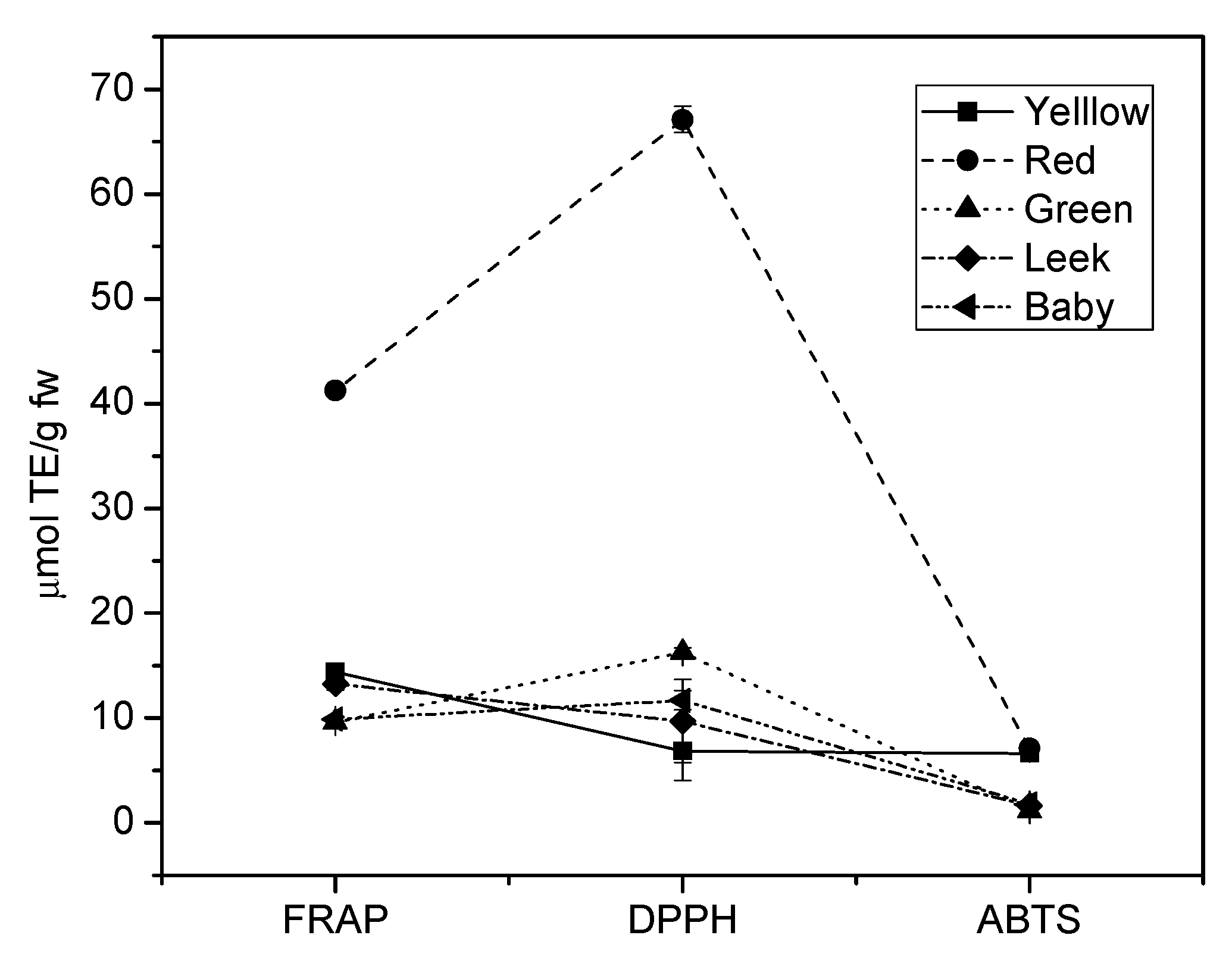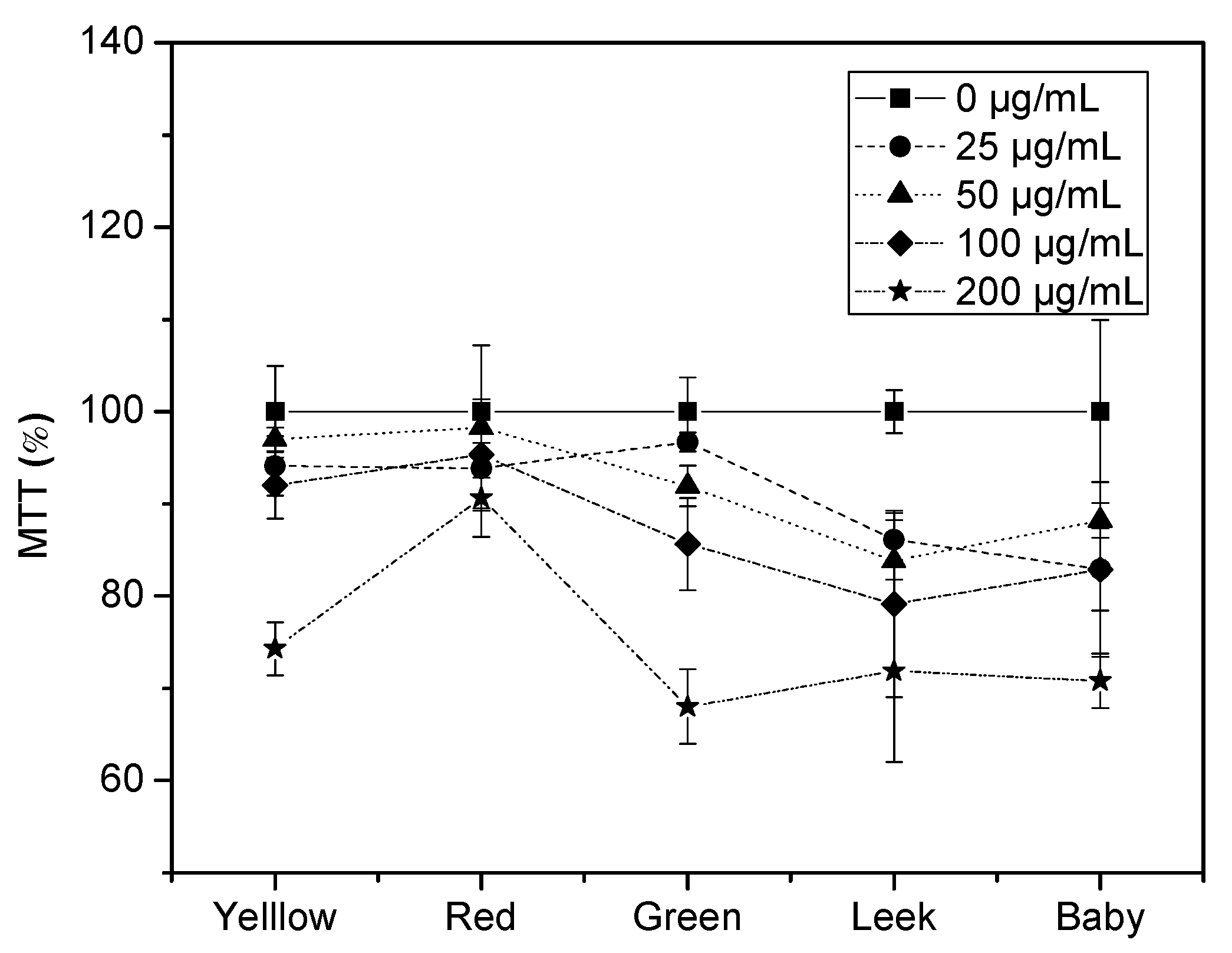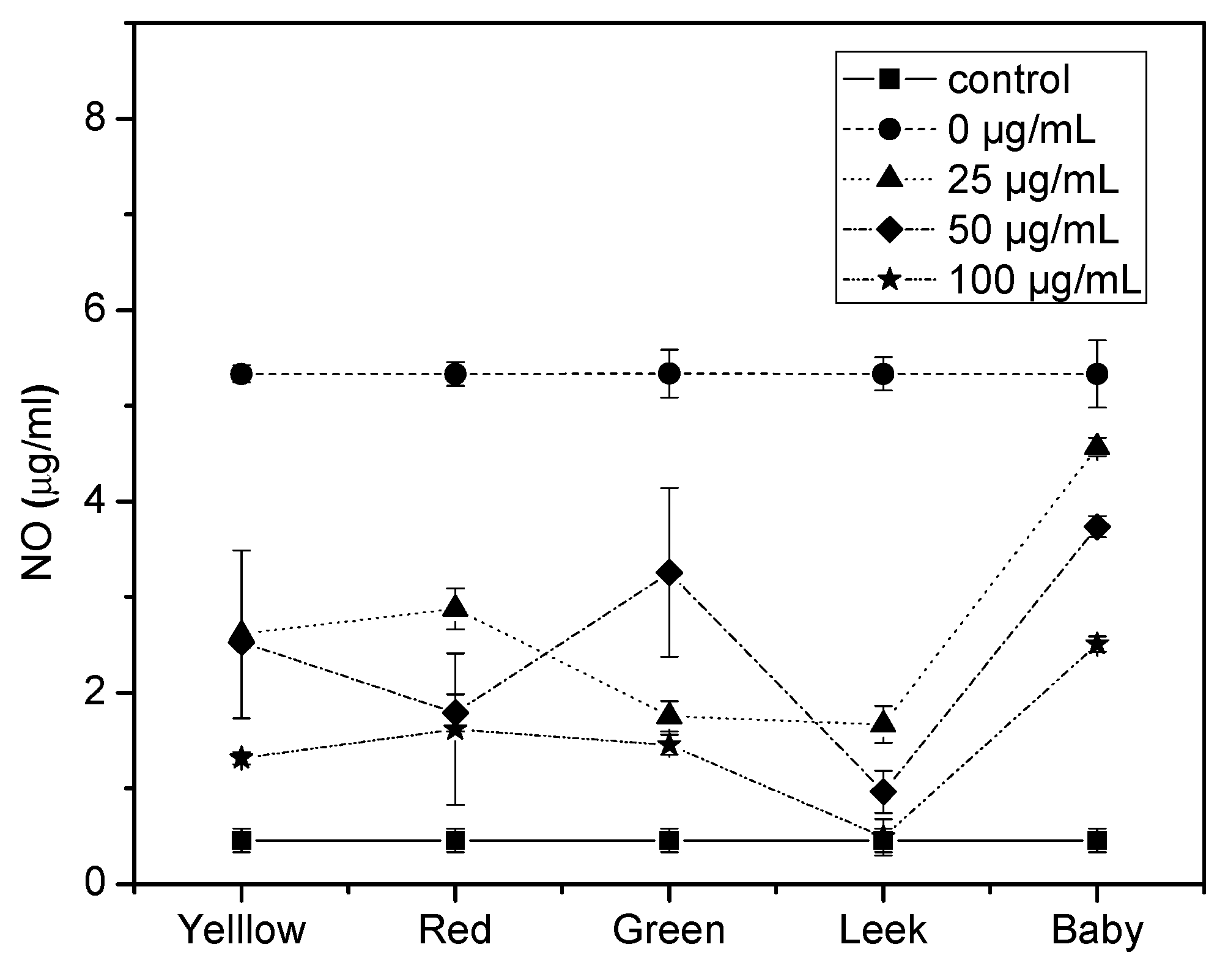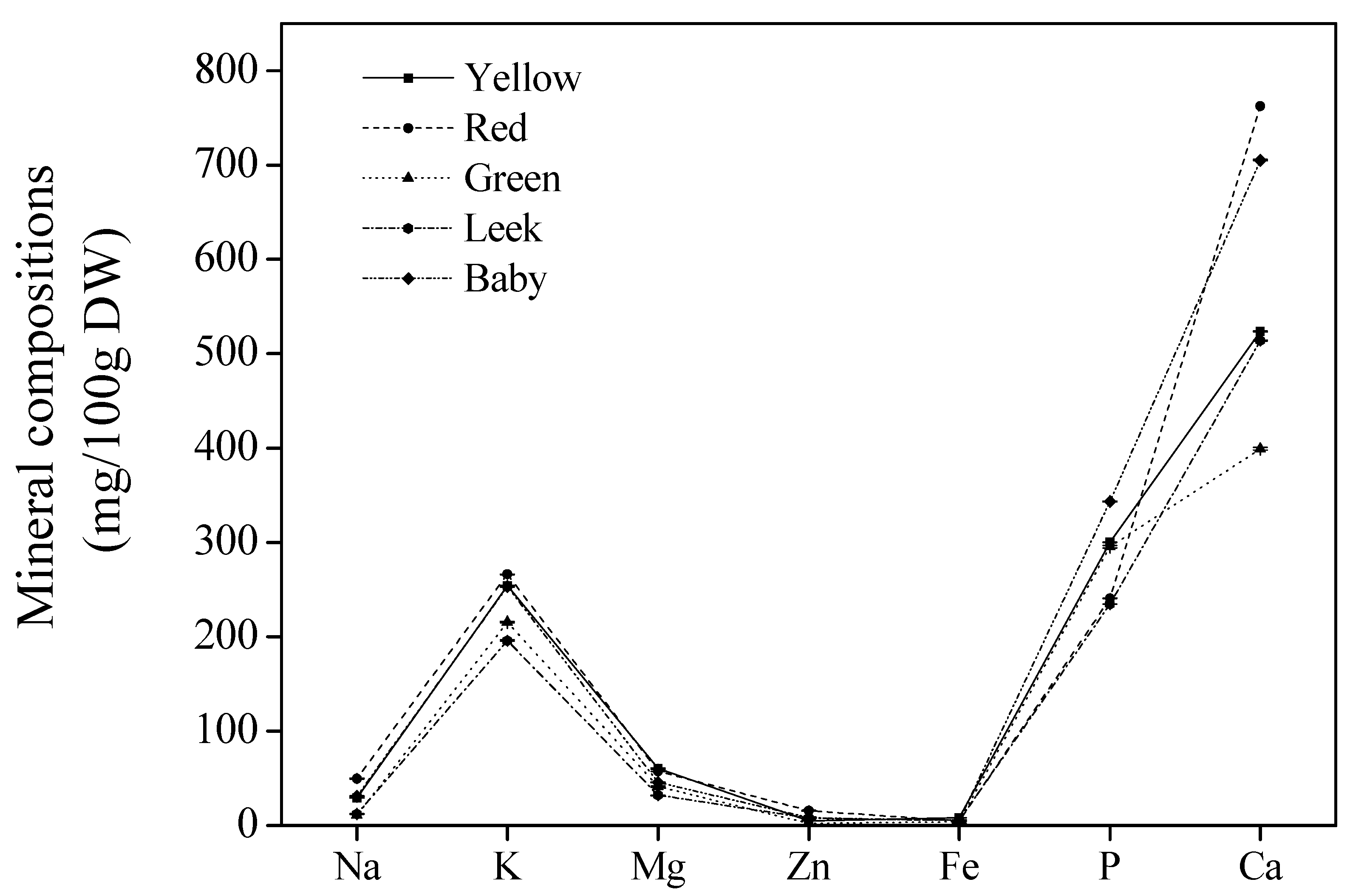In-Vitro Evaluation of the Antioxidant and Anti-Inflammatory Activity of Volatile Compounds and Minerals in Five Different Onion Varieties
Abstract
1. Introduction
2. Material and Methods
2.1. Chemical and Cells
2.2. Onion Preparation
2.3. Antioxidant Extraction
2.4. Flavonoid Content
2.5. Phenolic Content
2.6. Total Antioxidant Capacity
2.7. Antioxidant Activity Determinations
2.7.1. FRAP Assay
2.7.2. DPPH Assay
2.7.3. ABTS Assay
2.8. Anti-Inflammatory Activity
2.8.1. Extraction for Cell Culture
2.8.2. Cell Viability (MTT)
2.8.3. NO Production
2.9. Determination of Mineral Compositions
2.10. Gas Chromatography-Mass Spectrometry (GC-MS) Analysis for Volatile Compounds
2.11. Statistical Analysis
3. Results and Discussion
3.1. Total Flavonoid, Phenol, and Antioxidant Contents
3.2. Antioxidant Activity (FRAP-DPPH-ABTS)
3.3. Anti-Inflammatory Activity
3.3.1. MTT Reduction
3.3.2. NO Production
3.4. Mineral Compositions
3.5. Volatile Compounds
4. Conclusions
Author Contributions
Funding
Institutional Review Board Statement
Informed Consent Statement
Data Availability Statement
Acknowledgments
Conflicts of Interest
References
- Barla, S.; Upasani, R. Study on Different Methods of Weed Management in Onion (Allium cepa L.). Curr. J. Appl. Sci. Technol. 2019, 33, 1–7. [Google Scholar] [CrossRef]
- Sami, R.; Bushnaq, T.; Radhi, K.; Benajiba, N.; Helal, M. Prevalence of thinness cases and dietary diversity among learners of various education stages in Taif Region, Saudi Arabia. Afr. J. Food Agric. Nutr. Dev. 2020, 20, 17081–17094. [Google Scholar]
- Sami, R.; Alshehry, G.; Elgarni, E.; Helal, M. Saudi community care awareness food facts, nutrients, immune system and COVID-19 preventionin TaifCity among different age categories. Afr. J. Food Agric. Nutr. Dev. 2021, 21, 17213–17233. [Google Scholar]
- Sharma, K.; Mahato, N.; Nile, S.H.; Lee, E.T.; Lee, Y.R. Economical and environmentally-friendly approaches for usage of onion (Allium cepa L.) waste. Food Funct. 2016, 7, 3354–3369. [Google Scholar] [CrossRef] [PubMed]
- Edet, A.; Eseyin, O.; Aniebiet, E. Anti-nutrients composition and mineral analysis of allium cepa (onion) bulbs. Afr. J. Pharm. Pharmacol. 2015, 9, 456–459. [Google Scholar]
- Sami, R.; Elhakem, A.; Alharbi, M.; Benajiba, N.; Almatrafi, M.; Helal, M. Nutritional Values of Onion Bulbs with some Essential Structural Parameters for Packaging Process. Appl. Sci. 2021, 11, 2317. [Google Scholar] [CrossRef]
- Feng, H.; Sami, R.; Li, Y.; Jiang, L.; Cao, W. High-performance size-exclusion chromatography studies on the formation and distribution of polar compounds in camellia seed oil during heating. J. Zhejiang Univ. Sci. B 2016, 17, 882–891. [Google Scholar] [CrossRef] [PubMed]
- Li, Y.; Ma, W.; Qi, B.; Sami, R.; Li, D.; Wang, J.; Feng, H.; Sui, X.; Jiang, L. Blending of Soybean Oil with Selected Vegetable Oils: Impact on Oxidative Stability and Radical Scavenging Activity. Asian Pac. J. Cancer Prev. 2014, 16, 2583–2589. [Google Scholar] [CrossRef]
- Elhakem, A.; Benajiba, N.; Khojah, E.; Koko, M.; Sami, R. DPPH, FRAP and TAEC Assays with postharvest cabbage (Brassica Oleracca) parameters during the packaging process. Pak. J. Agric. Sci. 2020, 24, 182–187. [Google Scholar]
- Sami, R. Antioxidant Properties of Peptides from Soybean Meal Protein Hydrolysates Evaluated by Electron Spin Resonance Spectrometry. Adv. Environ. Biol. 2017, 11, 12–18. [Google Scholar]
- Sami, R.; Alshehry, G.; Ma, Y.; Abdelazez, A.; Benajiba, N. Evaluation of some specific components existences in Okra (Abelmoschus esculentus L. (Moench)) cultivated from different areas. J. Food Nutr. Res. 2019, 7, 155–161. [Google Scholar]
- Wang, H.; Sun, Y.; Li, Y.; Tong, X.; Regenstein, J.M.; Huang, Y.; Ma, W.; Sami, R.; Qi, B.; Jiang, L. Effect of the condition of spray-drying on the properties of the polypeptide-rich powders from enzyme-assisted aqueous extraction processing. Dry. Technol. 2019, 37, 2105–2115. [Google Scholar] [CrossRef]
- Qiao, G.; Wenxin, D.; Zhigang, X.; Sami, R.; Khojah, E.; Amanullah, S. Antioxidant and anti-inflammatory capacities of pepper tissues. Ital. J. Food Sci. 2020, 32, 265–274. [Google Scholar]
- Sami, R.; Khojah, E.; Elgarni, E.; Benajiba, N. Evaluation of Nutritional Status for some Sensitive Sets and it is Relationship to Natural Antioxidants. J. King Abdulaziz Univ. Med Sci. 2016, 24, 1–9. [Google Scholar] [CrossRef]
- Abeer, H.; Almatrafi, M.; Benajiba, N.; Koko, M.; Sami, R. Comparative analysis of bioactive compounds, antioxidant and anti-inflammatory activities of apple varieties. Asian J. Plant. Sci. 2021, 20, 61–66. [Google Scholar]
- Khojah, E.; Sami, R. Fatty Acids Composition and Oxidative Stability of Peanut and Sesame Oils with the Sensory Evaluation of Mayonnaise Prepared by Different Oils. Assiut J. Agric. Sci. 2016, 47, 460–472. [Google Scholar]
- Zhang, D.; Zhang, H.; Lao, Y.; Wu, R.; Xu, J.; Murad, F.; Bian, K.; Xu, H. Anti-Inflammatory Effect of 1,3,5,7-Tetrahydroxy-8-isoprenylxanthone Isolated from Twigs of Garciniaesculenta on Stimulated Macrophage. Mediat. Inflamm. 2015, 2015, 350564. [Google Scholar] [CrossRef]
- Vivek, K.; Singh, S.S.; Sasikumar, R.; Sami, R. Consumer Preference Study on Combined Ultrasound and Sodium Hypochlorite Treated Fresh cut Kiwifruits Coated with Chitosan Using the Fuzzy Logic Approach. J. Microbiol. Biotechnol. Food Sci. 2021, e4054. [Google Scholar] [CrossRef]
- Sami, R.; Li, C.-J.; Zhao, Y.; Li, Y.; Sun, C.-H. Cabbage (Brassica oleracea L. var. capitata) phytochemicals with antioxidant and anti-inflammatory potential. Asian Pac. J. Cancer Prev. 2013, 14, 6657–6662. [Google Scholar]
- Sami, R.; Elhakem, A.; Alharbi, M.; Benajiba, N.; Almatrafi, M.; Abdelazez, A.; Helal, M. Evaluation of Antioxidant Activities, Oxidation Enzymes, and Quality of Nano-Coated Button Mushrooms (Agaricus bisporus) during Storage. Coatings 2021, 11, 149. [Google Scholar] [CrossRef]
- Prasad, N.; Yang, B.; Kong, K.W.; Khoo, H.E.; Sun, J.; Azlan, A.; Ismail, A.; Romli, Z.B. Phytochemicals and antioxidant capacity from Nypa fruticans Wurmb. fruit. Evid. Based Complementary Altern. Med. 2013, 2013, 154606. [Google Scholar] [CrossRef]
- Al-Smadi, M.; Al-Momani, F. Synthesis, characterization and antimicrobial activity of new 1, 2, 3-selenadiazoles. Molecules 2008, 13, 2740–2749. [Google Scholar] [CrossRef] [PubMed]
- Sami, R.; Elhakem, A.; Alharbi, M.; Benajiba, N.; Fikry, M.; Helal, M. The combined effect of coating treatments to nisin, nano-silica, and chitosan on oxidation processes of stored button mushrooms at 4 °C. Sci. Rep. 2021, 11, 1–9. [Google Scholar] [CrossRef]
- Van Tonder, A.; Joubert, A.M.; Cromarty, A.D. Limitations of the 3-(4, 5-dimethylthiazol-2-yl)-2, 5-diphenyl-2H-tetrazolium bromide (MTT) assay when compared to three commonly used cell enumeration assays. BMC Res. Notes 2015, 8, 1–10. [Google Scholar] [CrossRef] [PubMed]
- Lee, J.-K.; Murakami, A.; Watanabe, S.; Ohigashi, H. Suppressive properties of extracts from Japanese edible plants regarding nitric oxide generation. Asian Pac. J. Cancer Prev. 2009, 10, 263–272. [Google Scholar] [PubMed]
- Sami, R.; Jiang, L.; Li, Y.; Ma, Y.; Jing, J. Evaluation of Fatty Acid and Amino Acid Compositions in Okra (Abelmoschus esculentus) Grown in Different Geographical Locations. BioMed Res. Int. 2013, 2013, 574283. [Google Scholar] [CrossRef] [PubMed]
- Gonzales-Barron, U.; Butler, F. A comparison between the discrete Poisson-gamma and Poisson-lognormal distributions to characterise microbial counts in foods. Food Control 2011, 22, 1279–1286. [Google Scholar] [CrossRef]
- Nile, S.H.; Nile, A.S.; Keum, Y.-S. Total phenolics, antioxidant, antitumor, and enzyme inhibitory activity of Indian medicinal and aromatic plants extracted with different extraction methods. 3 Biotech. 2017, 7, 1–10. [Google Scholar] [CrossRef]
- Sami, R.; Almatrafi, M.; Elhakem, A.; Alharbi, M.; Benajiba, N.; Helal, M. Effect of Nano Silicon Dioxide Coating Films on the Quality Characteristics of Fresh-Cut Cantaloupe. Membranes 2021, 11, 140. [Google Scholar] [CrossRef]
- Santas, J.; Carbo, R.; Gordon, M.; Almajano, M. Comparison of the antioxidant activity of two Spanish onion varieties. Food Chem. 2008, 107, 1210–1216. [Google Scholar] [CrossRef]
- Lu, X.; Wang, J.; Al-Qadiri, H.M.; Ross, C.F.; Powers, J.R.; Tang, J.; Rasco, B.A. Determination of total phenolic content and antioxidant capacity of onion (Allium cepa) and shallot (Allium oschaninii) using infrared spectroscopy. Food Chem. 2011, 129, 637–644. [Google Scholar] [CrossRef]
- Eldib, R.; Khojah, E.; Elhakem, A.; Benajiba, N.; Helal, M. Chitosan, Nisin, Silicon Dioxide Nanoparticles Coating Films Effects on Blueberry (Vaccinium myrtillus) Quality. Coatings 2020, 10, 962. [Google Scholar] [CrossRef]
- Curti, V.; Di Lorenzo, A.; Dacrema, M.; Xiao, J.; Nabavi, S.M.; Daglia, M. In vitro polyphenol effects on apoptosis: An update of literature data. Semin. Cancer Biol. 2017, 46, 119–131. [Google Scholar] [CrossRef] [PubMed]
- Elliott, P.; Kesteloot, H.; Appel, L.J.; Dyer, A.R.; Ueshima, H.; Chan, Q.; Brown, I.J.; Zhao, L.; Stamler, J. Dietary phosphorus and blood pressure: International study of macro-and micro-nutrients and blood pressure. Hypertension 2008, 51, 669–675. [Google Scholar] [CrossRef]
- Houston, M.C.; Harper, K.J. Potassium, magnesium, and calcium: Their role in both the cause and treatment of hypertension. J. Clin. Hypertens. 2008, 10, 3–11. [Google Scholar] [CrossRef]
- Akinwande, B.; Olatunde, S. Comparative evaluation of the mineral profile and other selected components of onion and garlic. Int. Food Res. J. 2015, 22, 332–336. [Google Scholar]
- Poojary, M.M.; Putnik, P.; Kovačević, D.B.; Barba, F.J.; Lorenzo, J.M.; Dias, D.A.; Shpigelman, A. Stability and extraction of bioactive sulfur compounds from Allium genus processed by traditional and innovative technologies. J. Food Compos. Anal. 2017, 61, 28–39. [Google Scholar] [CrossRef]
- Liu, M.; Su, Y.; Guo, Y. Determination of highly volatile compounds in fresh onion (Allium cepa L.) by room-temperature enrichment headspace-trap coupled to cryotrapping GC–MS. Sep. Sci. Plus 2018, 1, 530–538. [Google Scholar] [CrossRef]




| Total Flavonoid mg Qe/g dw | Total Phenol mg/g dw | Total Antioxidant µg AAE/mg | |
|---|---|---|---|
| Yellow | 163.20 ± 11.83 c | 21.61 ± 1.37 b | 11.16 ± 0.35 c |
| Red | 253.55 ± 23.15 b | 25.73 ± 0.74 a | 12.27 ± 0.22 b |
| Green | 12.56 ± 0.36 e | 8.75 ± 0.62 d | 5.47 ± 0.08 e |
| Leek | 353.53 ± 5.64 a | 20.35 ± 0.78 b | 12.80 ± 0.08 a |
| Baby | 81.13 ± 3.55 d | 17.54 ± 2.16 c | 9.63 ± 0.46 d |
| Yellow | Red | Green | Leek | Baby | |
|---|---|---|---|---|---|
| Ethyl sulfide | n.d. | 0.01 ± 0.00 c | 0.07 ± 0.00 b | 0.06 ± 0.01 b | 0.20 ± 0.29 a |
| Dimethyl sulfide | 1.18 ± 0.26 a | 0.19 ± 0.55 c | 0.06 ± 0.00 d | 0.17 ± 0.06 c | 1.12 ± 0.27 b |
| 3,3-Thiobis-1-propene | 0.07 ± 0.08 a | n.d. | n.d. | 0.04 ± 0.04 b | 0.01 ± 0.07 c |
| n-Propyl cis-1-propenyl sulfide | 0.06 ± 0.34 a | 0.02 ± 0.54 b | n.d. | 0.03 ± 0.05 b | 0.01 ± 0.34 b |
| Methyl allyl disulfide | 2.53 ± 0.54 a | 1.89 ± 0.88 b | 1.45 ± 0.88 c | 0.06 ± 0.09 e | 0.99 ± 0.53 d |
| Diethyl disulfide | n.d. | 0.02 ± 0.29 a | 0.01 ± 0.55 b | 0.02 ± 0.09 a | 0.01 ± 0.01 b |
| Methyl-trans-propenyl-disulfide | 1.32 ± 0.21 a | 1.19 ± 0.29 b | 0.98 ± 0.55 c | 0.07 ± 0.00 d | 1.30 ± 0.09 a |
| Methyl propyl disulfide | 1.12 ± 0.41 c | 2.22 ± 0.07 b | 0.04 ± 0.44 d | 2.17 ± 0.05 b | 5.21 ± 0.00 a |
| Propionaldehyde | 16.87 ± 0.59 b | 6.44 ± 0.34 d | 5.98 ± 0.54 e | 12.66 ± 0.44 c | 48.16 ± 1.05 a |
| 2-Methyl-2-pentenal | n.d. | 3.87 ± 0.53 d | 46.88 ± 0.88 b | 65.87 ± 1.54 a | 39.00 ± 1.03 c |
| Furfuraldehyde | 39.65 ± 0.17 e | 82.65 ± 0.53 d | 113.65 ± 0.88 b | 98.65 ± 0.88 c | 166.32 ± 1.05 a |
| 5-Methyl-2-furfuraldehyde | 88.87 ± 0.29 b | 68.86 ± 0.29 c | 13.65 ± 0.55 e | 35.77 ± 0.55 d | 105.55 ± 0.19 a |
| 1-Propanethiol | 8.09 ± 0.07 e | 14.11 ± 0.07 a | 10.08 ± 0.00 c | 13.10 ± 0.55 b | 9.19 ± 0.55 d |
| Dimethyl disulfide | 0.12 ± 0.34 b | 0.10 ± 0.03 c | 0.13 ± 0.00 a | n.d. | n.d. |
| 2-Methylpentanal | 0.10 ± 0.53 c | 0.11 ± 0.05 b | 0.14 ± 0.00 a | 0.10 ± 0.50 c | n.d. |
| (E)-Hex-2-enal | 0.11 ± 0.20 e | 0.32 ± 0.02 a | 0.28 ± 0.01 b | 0.21 ± 0.55 d | 0.24 ± 0.88 c |
| (Z)-Hex-3-en-1-ol | 0.20 ± 0.56 d | 0.24 ± 0.00 a | 0.21 ± 0.00 c | 0.20 ± 0.00 d | 0.22 ± 0.29 b |
| (E)-Hex-3-en-1-ol | 0.75 ± 0.52 b | 0.90 ± 0.01 a | 0.71 ± 0.01 c | 0.54 ± 0.05 d | 0.32 ± 0.29 e |
| Propyl hydrosulfide | 0.32 ± 0.44 c | 0.33 ± 0.04 b | 0.31 ± 0.06 d | 0.40 ± 0.44 a | 0.22 ± 0.07 e |
| S-Propyl ethanetihoate | 0.18 ± 0.54 e | 1.50 ± 0.05 a | 0.99 ± 0.04 d | 1.33 ± 0.54 b | 1.30 ± 0.34 c |
| 2,5-Dimethylthiophene | 0.20 ± 0.51 b | 0.10 ± 0.01 d | 0.21 ± 0.06 c | 0.20 ± 0.55 b | 0.23 ± 0.87 a |
Publisher’s Note: MDPI stays neutral with regard to jurisdictional claims in published maps and institutional affiliations. |
© 2021 by the authors. Licensee MDPI, Basel, Switzerland. This article is an open access article distributed under the terms and conditions of the Creative Commons Attribution (CC BY) license (https://creativecommons.org/licenses/by/4.0/).
Share and Cite
Sami, R.; Elhakem, A.; Alharbi, M.; Almatrafi, M.; Benajiba, N.; Ahmed Mohamed, T.; Fikry, M.; Helal, M. In-Vitro Evaluation of the Antioxidant and Anti-Inflammatory Activity of Volatile Compounds and Minerals in Five Different Onion Varieties. Separations 2021, 8, 57. https://doi.org/10.3390/separations8050057
Sami R, Elhakem A, Alharbi M, Almatrafi M, Benajiba N, Ahmed Mohamed T, Fikry M, Helal M. In-Vitro Evaluation of the Antioxidant and Anti-Inflammatory Activity of Volatile Compounds and Minerals in Five Different Onion Varieties. Separations. 2021; 8(5):57. https://doi.org/10.3390/separations8050057
Chicago/Turabian StyleSami, Rokayya, Abeer Elhakem, Mona Alharbi, Manal Almatrafi, Nada Benajiba, Taha Ahmed Mohamed, Mohammad Fikry, and Mahmoud Helal. 2021. "In-Vitro Evaluation of the Antioxidant and Anti-Inflammatory Activity of Volatile Compounds and Minerals in Five Different Onion Varieties" Separations 8, no. 5: 57. https://doi.org/10.3390/separations8050057
APA StyleSami, R., Elhakem, A., Alharbi, M., Almatrafi, M., Benajiba, N., Ahmed Mohamed, T., Fikry, M., & Helal, M. (2021). In-Vitro Evaluation of the Antioxidant and Anti-Inflammatory Activity of Volatile Compounds and Minerals in Five Different Onion Varieties. Separations, 8(5), 57. https://doi.org/10.3390/separations8050057






